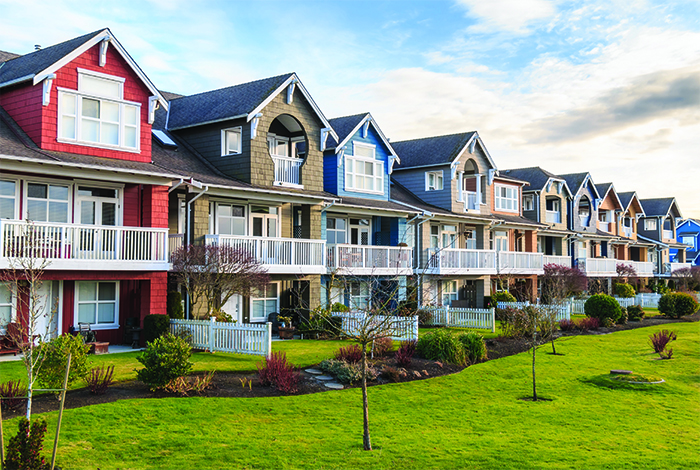
2016 Economic Forecast
For decades prior to the Great Recession, the Pittsburgh housing market was fairly unremarkable. Trends in population growth, housing types or mortgage financing happened elsewhere. Pittsburgh was slow and steady. That’s a description that many locals take pride in espousing but it’s also a recipe for a stagnation of sorts; and the home prices in Pittsburgh reflected that. Unlike in other cities, home ownership in Pittsburgh had little risk but also little reward. From almost any perspective, Pittsburgh’s housing market lagged or ran counter to the national trends. Little about the market was newsworthy. That all changed after 2008.
Slow and steady is an unattractive description for most investors. Consumers in other cities saw home price appreciation that was five or ten times higher than appreciation in Pittsburgh and homes sold like hot cakes. In mid-2007 we began to understand why some of these hot markets were so overheated. The artificial growth in values that came from demand from investors, flippers and unqualified buyers fueled the housing bubble and the crisis that followed. None of those dynamics happened in Pittsburgh. Neither did the chaos that followed.
While dozens of major U.S. cities began to see homes foreclosed by the thousands and prices declined as much as 50 percent, Pittsburgh saw the kinds of conditions that occurred during other slow business cycles. Property values edged down a little overall but many desirable communities still saw prices go up slightly. By 2010, property values in Pittsburgh resumed an upward trend. With unemployment much lower in Pittsburgh, and growth in the kinds of jobs that would fuel the economy of the future, the housing market in Pittsburgh got healthier faster than almost any other city in America. The conditions were perfect for a housing boom. But that boom never happened. There was no rush to the market by existing homeowners to take advantage of the higher-than-normal appreciation. New construction didn’t even return to pre-recession levels, let alone take off as a relief valve for the lack of existing home inventory. What did happen in Pittsburgh was that the region’s housing market was very much in line with the national trend – even a step ahead.
Through 2015, the story line in Pittsburgh was the same as that of the rest of the country. Prices continued to climb. Inventory of homes for sale continued to decline. New construction didn’t pick up the slack (or even fully recover). Money was cheap to borrow but regulations kept lending conservative. Younger people weren’t buying houses so construction of apartments surged. Slow and steady became the national mantra again.
Now in 2016, the housing market in the U.S. is seeing a shift in direction and that same shift is being seen in Pittsburgh. There are changes in several key factors in housing that should influence the market for the next year or so: The drivers of apartment development have changed; Demographics will shift housing demand; Lending conditions will influence housing again; and in Pittsburgh, the makeup of the builders shaping new construction. Like in 2007, we can see changes coming in the housing market. Unlike in 2007, change won’t hurt.
The Big Numbers
Housing was a train that went off the rails in the mid-2000s. It was only after the wreck that we discovered just how far off the rails the market went. At the time of the financial crisis, the worst pessimists predicted that it would take until 2014 before the overhanging inventory of homes would be absorbed and growth could begin again. That turned out to be an optimistic forecast but in 2016 we can now see more clearly what the numbers meant.
Even a cursory glance at the housing start data over the past decade reveals that new construction of homes has remained at severely depressed levels compared to history. The overbuilding of the mid-2000s came from over-lending and the upshot was that credit problems created a huge number of renters that had previously been owners. As the Millennial generation entered the workforce, its members had more college debt and greater concern about borrowing money than older generations. As a result, demand for new households and new construction fell precipitously and remained low.
Those conditions also meant that demand for apartments and rental homes went through the roof. Commercial real estate investors flocked to back multi-family development. Lenders liked the returns on investment and the lower risk of apartment projects. Rents went up as vacancy went down. Apartment construction boomed all over the country and increased significantly in Pittsburgh as well. Like in other cities, development of new apartment projects in Pittsburgh was also accompanied by new design trends, which included smaller units, more lifestyle amenities, more urban development and the creation of multiple public social spaces within the common area of the complex.
As 2015 wound down, there was growing evidence that demand for apartments was starting to wane. Lenders were becoming wary and less willing to finance new construction. In Pittsburgh, absorption remained high – more than 535 units for the third consecutive year – but lagged the amount of supply entering the market again by a similar margin.
The history of multi-family development is very cyclical. New construction has generally gone on a year or two after demand slows so that overbuilding occurs. Most observers seem to feel the apartment market is at the overbuilding point in 2016 but the numbers don’t necessarily support the feeling that the party is over for new development. Nor does data show that the normal single-family demand cycle is about to take off.
For example, while the U.S. multi-family market has been booming since the beginning of the recovery in 2010, the volume of star ts actually only rose above the 50-year average of 359,000 units in 2015. Moreover, the peak of two earlier boom cycles – in 1985 and 1972 – reached 576,000 units and 902,000 units respectively. Construction of multi-family units appears to be peaking in early 2016 at somewhere above 425,000 units, but a slowdown below the average is more likely for the full year.
Even more inexplicable is the protracted sluggishness in the U.S. single-family market. Starts in this category of housing peaked in 1972, 1978 and again in 2005, when 2.068 million units were started. In the 48 years prior to 2005, the average number of single-family units started was above 1.546 million units. Construction dropped off dramatically from 2006 to 2009, when only 554,000 single-family houses were started. The overextension of mortgages during the housing bubble created an excess inventory that had to be sold prior to the resurgence of new construction. By all measures, that overhanging inventory has been absorbed for two years or more, yet new construction only recovered to the one million-unit level in 2014 and the average number of starts in the intervening eight years has been 809,400.
At our local level, the numbers are even more inexplicable. New construction of single-family homes peaked in Pittsburgh in 2004, well before the housing bubble popped. Since the 2009 recession, the volume of new homes built has only topped 2,000 units once, in 2014. During that same economic recovery cycle, new job creation – which drives population growth and household formation – has well outstripped the amount of housing built of all types. The demographics and job growth may explain why 500 more apartment units were absorbed each year since 2010. But with the growth of jobs that is forecast for the next three years – some 36,000 jobs – demand for housing in Pittsburgh could be building rather than waning.
Why examine all these numbers? Well, the narrative about the housing market has been pretty consistent and persistent since 2009. The housing crisis created millions of renters and left millions of houses to be absorbed. But the data tells us that almost ten years later, all those new renters didn’t actually create a boom – at least not by historical standards. The numbers also suggest that demand for home ownership should be way ahead of supply by 2016, foretelling a dramatic increase in demand for homes to buy (or build). The latter is especially true if the huge Millennial generation is about to start having children. Yet construction and sales of existing homes is not booming.
“In the Western PA resale market we haven’t seen an uptick in inventory for sale,” notes Howard “Hoddy” Hanna III, CEO of Pittsburgh-based Howard Hanna Real Estate Services, the nation’s fourth-largest realtor. “That is not true in our other markets and in other markets we look at. The only place we’re seeing oversupply in the market is in the upper five percent of the price range.”
Perhaps the numbers aren’t telling the story. The housing market changed because of the bubble so the historic housing cycle hasn’t moved in the same way. There has been nothing in the past to suggest that a major cyclical change is occurring either. Of course, the last time that the numbers suggested that the housing market wasn’t behaving as it should was 2006.
Keeping an Eye on the Demographics
One of the more influential trends of the past decade has been the aging of the Baby Boomers. Because Pittsburgh has an older population, the lifestyle choices of aging Boomers had a bigger impact in Western PA, including the impact on housing.
The dominant traits of the lifestyle being chosen by aging Boomers were having a sense of community with others of the same stage in life and having little or no maintenance responsibilities. These demands fueled new construction mostly, as little or no existing home product was in the market. In the late 1990s, that demand initially translated into a boom in independent living facilities and the continuum of care concept; but the more institutional style of living those facilities offered soon fell flat among residents. Around the turn of the century, a lifestyle option that was taking off in other markets came to Pittsburgh.
Bill Weaver, owner of Weaver Custom Homes, was one of the first builders in Western PA to shift his business towards meeting this untapped need. Weaver researched the options and chose to ally his business with Epcon Communities, which had developed a number of attached and detached home concepts for aging in place. The formula has been a great success, as Weaver grew from building 10 or 15 homes each year to five times that number.
“The Epcon franchise, that’s been our core product and it always will be,” says Weaver. The communities Weaver has developed have quad-plexes as the main housing option. He says that buyers are attracted to the no maintenance lifestyle that allows them to have a two or three bedroom home in a neighborhood with a pool and clubhouse that are frequented by people in the same stage in life. Weaver’s communities are nearby places that have strong single-family neighborhoods, like Cranberry and Adams Township or Zelienople.
“People don’t want to leave their churches. They don’t want to leave their friends. As long as they can get in their cars and get to those things in ten minutes or so, that’s perfect,” he asserts, citing his success at Bellevue Park and a new community called the Glen at Woodside in Cranberry as examples. “At [the Glen at Woodside] we have two models under construction but we’ve sold five lot reservations and three contracts selling out of a trailer, which I hate to do.”
Another builder taking advantage of the over-55 market is Brennan Builders. One of the most active custom builders in the North Hills for decades, Brennan continues to have success in that market but has seen the shift in demographics as an opportunity for growth.
“Our success isn’t so much about location as it is about product,” notes Tricia Brennan, who runs Brennan Builders with her father Bob. “We’re doing very well with the multi-unit product for buyers who don’t want traditional homes.” Brennan is building duplexes, quads and townhomes in The Gables in Mars and the Hunt Club at Grandview in West Deer Township.
Time is the enemy of all trends, of course. Boomers heading into retirement have been a great market changer for housing and should remain a significant influence upon development for a while longer. Says Weaver, “Epcon keeps a good handle on projections and we’re told to expect Boomers to have influence for another 10 or 15 years.” But as that demographic group ages further, the future of the housing industry rests with the group of adults at the other end of the spectrum.
If one factor could be isolated as the key to a new boom in single-family housing it is the pent-up demand from first-time buyers. Whether at the national level or in Pittsburgh, the shift by Millennial generation adults from renting to buying – which is likely to coincide with that group beginning to raise children – will trigger a significant increase in demand for homes. Determining that tipping point won’t be easy but if history is an indication, a shift will occur when the median age of the Millennials is 30. That should occur sometime in 2017-2018.
One custom builder in Pittsburgh has seen a change in the mix of his customers already. Mark Heinauer, president of Barrington Homes, builds homes at the higher end of the price range but says that his clients aren’t necessarily the traditional middle-aged move-up type.
“We have quite a few customers who are younger, in their 30s, and building pretty big houses,” Heinauer notes. “Not all of them are over a million dollars but we’re talking about $800,000 or more. One of the other things I see is people who moved away from Pittsburgh moving back. We see quite a few people doing that right now. They may have lived in New York or Chicago or North Carolina but they are choosing to move back home. That’s pretty cool.”
Heinauer is seeing the impact of what may be a very influential trend in Pittsburgh and throughout the U.S. For decades, the generation born between 1948 and 1963 – the Baby Boomers – have been the driving force of the U.S. economy and culture. That generation is still influencing the housing market but the Boomers’ most enduring legacy may be that they gave birth to an even bigger demographic group, the group we call Millennials.
The age group that is between 25 and 35 entered the workforce as a Black Swan event was blowing up the housing market. The financial crisis has had a similar influence upon Millennials as the Great Depression had on adults in the 1930s. But now, as America’s young adults mature beyond single life, the onset of raising families seems to be driving their housing choices. Lifestyle choices and fear of home buying pushed Millennials into the cities and into apartments. Younger adults came into working life with higher levels of college debt. Saving and deleveraging were high priorities for Millennials. Now, some ten years later, Millennials are approaching home ownership with much more money in the bank than the Boomers did. The early evidence shows that their frugality is giving them options the Boomers didn’t have.
“Not all first-time home buyers are looking at purchasing a $120,000 house and then moving up over time,” notes Mike Henry, senior vice president, residential mortgages for Dollar Bank. “We’re seeing first-time buyers who are skipping over the starter home, looking at homes that are $250,000 or much more. Today’s first-time buyers are definitely different. Millennials are looking for different things than before.”
Henry sites the Homebuyers Insights Report done by Bank of America this winter, which shows that 75 percent of first-time buyers plan to skip the starter home. After paying down debt, Millennials and GenX-ers are planning to buy a first home that meets their long-term needs. In fact, the Bank of America survey found that 49 percent expected to retire in the home they purchase.
How much do national trends impact Pittsburgh? Well, for a long time Pittsburghers made the argument that what happened here was different than in other markets or happened 18 months later. The truth is that all local markets tend to be influenced by the same factors that are observed on a national scale. This particular trend, however, is especially relevant because Pittsburgh has become home to a greater share of Millennials than most cities. Unlike most American cities, Pittsburgh is getting younger. While the median age of the U.S. continues to climb, the median Allegheny County resident is slightly younger and the median age of a City of Pittsburgh resident has fallen dramatically over the past decade, now dropping to around 33 years old.
Employers that are driving growth in Pittsburgh are driving the future economy of the U.S. More important to demographics is the fact that these employers – ones engaged in new technology, healthcare and energy – are attracting a much younger workforce and paying much higher-than-average wages. That will drive the kinds of buyers that Mark Heinauer is seeing.
Mortgage Market Conditions
If the Millennial generation is about to burst into its child-rearing and home-buying years, its members will face conditions for mortgage borrowing that are different from those of older Americans – and conditions that aren’t all that different.
The buyers of homes – especially first-time buyers – who are between the ages of 25 and 30 came of age and entered the workforce under the influence of the Great Recession. As that age cohort was wrapping up its education and looking for first jobs, the daily headlines were of bank closings, foreclosures and massive layoffs. Many found it hard to find a good job. Many graduated with debt for their college education that was equal to the cost of a starter home. The emotional impact was similar to the Great Depression’s impact on their grandparents. The financial impact may have been even greater.
Whether from fear or frugality, younger Americans put off buying a home for longer than normal after 2008. For those who wanted to buy a home, a different lending environment existed. Since loose lending created the crisis of 2008-2009, lenders tightened underwriting and credit conditions. The Dodd Frank Wall Street Reform and consumer Protection Act of 2010 added regulations that made it tougher for banks to lend and for consumers to borrow. Many pundits have continued the narrative that mortgages are difficult to get, with borrowers having to save 20 percent for a down payment. According to bankers, that isn’t so and really never was.
“The perception is that you need 20 percent down and perfect credit but that’s not true. I think that may have discouraged some buyers,” says Henry. “We’ve been doing five percent conventional mortgages since I started in 1987. You need documentation – pay stubs and a W-2. You need a good credit score. You need a down payment. It really hasn’t changed all that much.”
Henry points out that there are many mortgage options, including using government-backed programs from the Federal Housing Administration (FHA) or Pennsylvania Home Finance Agency (PHFA). There are FHA loans requiring as little as 3.5 percent down and PHFA programs that provide home loan grants for buyers with qualifying incomes. The fallout from the financial crisis has actually been less about lending conditions and more about the hoops the lender must jump through. Banks still want to make loans, however, and they have learned to adapt to the new conditions.
“Every situation presents an opportunity to learn and improve. The financial crisis nearly ten years ago was no exception. Since then, new mortgage rules have been put in place to create a more transparent, easy-to-understand process and ensure that borrowers secure loans within their means,” explains Bill Tarpenning, senior vice president, mortgage banking for Northwest Savings Bank. “These rules help lenders better understand a borrower’s financial situation. For borrowers, they give clarity to the fees, rates and terms associated with their home loan.”
One rule, known as TILA-RESPA Integrated Disclosure (TRID) or “Know Before You Owe”, took effect last October, creating two simplified disclosures that use a clear, easy-to-understand format and language. The first, known as the Loan Estimate, is given to borrowers shortly after application. The second is the Closing Disclosure, which is delivered at least three days before closing. These documents offer borrowers a better understanding of the terms and costs associated with their mortgage and provide them with enough time to ask questions and make informed and responsible decisions. Although this new rule can slow the process, it creates better transparency between the borrower and lender.
“In addition to TRID, Ability to Repay rules (part of the Dodd/Frank legislation), went into effect in 2014,” remarks Tarpenning “These rules placed strict guidelines on what could and couldn’t be considered qualifying income when underwriting residential mortgage loans. Controlled by the Department of Housing and Urban Development (HUD), these rules have made it more difficult to qualify applicants. There are many new rules that have gone into effect—far too many to discuss here. Needless to say, qualifying for a mortgage has not gotten easier.”
The aim of all the rules put in place is ultimately to keep buyers from borrowing more than they have the ability to repay. As might be expected – and as Mike Henry pointed out – the borrower’s verifiable income is more of a focus for lenders than it was in the mid-2000s. Regulations make it harder for borrowers to take out a risky loan without knowing the risks. But the ultimate safeguard against buyers getting in over their head is common sense and homework. No amount of regulation is as effective as a buyer doing his or her research and planning for what the costs of borrowing – and owning a home – will be. That’s especially true for first-time homeowners.
“First, it’s important for first-time homebuyers to enter the mortgage process understanding what they can afford,” explains Tarpenning. “The general rule has been that housing expenses, including expected monthly mortgage payments, homeowners insurance and property taxes shouldn’t exceed more than 28 percent of the borrower’s total gross monthly income. It’s important that borrowers take a good look at their financial profile to avoid getting a home and payment they regret after closing. Finally, it’s important that borrowers do their research.”
Pittsburgh Market Conditions
Having experienced a generation of tough economic conditions, Pittsburgh has become one of the darlings of the U.S. economy since the Great Recession. It is an affordable place to live and work. The housing prices in Pittsburgh are reasonable and steady. And like many other facets of Pittsburgh life, the home market here is gaining a national reputation.
SmartAsset reported on March 21 that Pittsburgh was the fourth best market in the country for first-time buyers. The company based its rankings on several factors, listing price stability as a main ranking driver. Pittsburgh and Honolulu were the only two U.S. cities to have seen no price decline since 2010.
Nationwide’s 2016 first quarter Health of Housing Market report listed Pittsburgh at 19th out of the 40 largest markets (based on total number of households). The insurer and multi-family lender looks at demographics, employment growth, mortgage market and home prices, ranking markets from four down to negative four for the current conditions. Pittsburgh rated a two for the quarter (only two markets rated above a two). More telling is the fact that Nationwide’s rating for Pittsburgh has been a two going back through 2015, a sign that the growth of the market has been sustainable. That explains why prices keep rising steadily, if not spectacularly.
The reasoning behind these favorable ratings of Pittsburgh is sound enough – buyers need home values to hold while they adjust to all the expenses associated with home ownership – but stable home values don’t necessarily translate into one of the keys to a healthy buying environment: sufficient supply of modestly-priced homes. When and if the housing market lifts off in Pittsburgh, there are some market conditions that will be head winds.
Development of new lots nearly stopped during the Great Recession. That’s a problem for a market that already had a dwindling supply of lots. Changes in the character of the builders also occurred during the downturn. The region’s top two builders, Ryan Homes and Heartland Custom Homes, merged and the market has seen a dramatic rise in the number of homes built by production-oriented builders. Also, new production builders have entered the market. By 2015, nearly 60 percent of the single-family homes were built by six production-oriented builders.
Hoddy Hanna believes that a change in that trend may be starting.
“On new construction, anecdotally it seems like there has been a small resurgence by the small-to-medium sized custom builder. There have been more custom communities opening up. Since the middle of last year, there has been more credit available for development,” he says. “The lack of choice has impaired those looking to buy new. Whether it’s the location of the home, the size or the type of product being built, having more choices encourages buyers.”
The upshot of these market condition changes has been that new home buyers will have more similarity of choices than buyers did in the more custom home driven market 10 years ago. That could pose a problem for the first-time Millennial buyers, which have demonstrated a desire for customization in many of its lifestyle choices. Economic realities are likely to bend how new buyers view their options, however, as costs continue to rise for homes and first-time buyers have to evaluate the value of customization versus truly custom.
Concerns about the depth of the apartment market are beginning to push back on the wave of new development in 2016. After three years of construction of more apartments than single-family homes, the tide will turn this year. There isn’t much evidence to suggest that a boom in single-family housing is going to start in 2016 but the economic conditions for pent-up demand to kick in are growing.
Howard Hanna Real Estate Services’ forecast for 2016 was for an increase in units sold of six-to-seven percent, with sales volume growing by eight or nine percent. Through the first three months of the year, Hanna says that about three percent more homes sold compared to 2015 but volume was up six-to-seven percent. He expects that disparity between price and units to continue through the rest of the year.
What will ultimately drive the forecast for the housing market in Pittsburgh will be an increase in the number of jobs created. The Bureau of Labor Statistics first report of employment growth in Pittsburgh for 2015 was at a 1.2 percent rate, or about 14,000 jobs. At even conservative household formation rates, that number of new jobs should have driven more household formations that there were new homes or apartments. Recently, Moody’s Analytics predicted that job growth in Pittsburgh would add 36,000 to the workforce in the next two years. With much of those new jobs going to younger, better-paid workers, Pittsburgh’s housing inventory will be under even more pressure before 2020. That’s a recipe for higher home values and for new construction.
At the end of the first quarter it was clear that the prevailing trend in the housing market had changed. Some 433 permits had been issued for single-family detached homes, an increase of 8.5 percent over the first quarter of 2015. That number of new single-family homes, combined with 166 attached single-family homes represents new construction that is in line with the volume of new homes since 2010. The big departure from the trend was in the apartment market. During the first quarter there were no permits issued for new multi-family projects, which reflects the change in sentiment about apartments from lenders and developers in the region.
Pittsburgh Homebuilding Report had forecast a decline in apartment starts to 2,544 and an increase in single-family starts to 2,280 for 2016; however, after the first quarter that forecast for apartments looks optimistic. A deep dive into the development pipeline shows that around 3,000 of the proposed 4,800 units have slowed, with no schedule for starting at the moment.
Mark Heinauer sees continued success in that recipe and is excited about the prospect of new growth in a market that has earned a reputation for stability. He thinks that stability makes it harder to predict when trends are changing.
“The city has been through good spurts before but nothing like we’ve seen in the past few years,” he says. “Pittsburgh has staying power.” mg












